Intel Unveils Meteor Lake Architecture: Intel 4 Heralds the Disaggregated Future of Mobile CPUs
by Gavin Bonshor on September 19, 2023 11:35 AM EST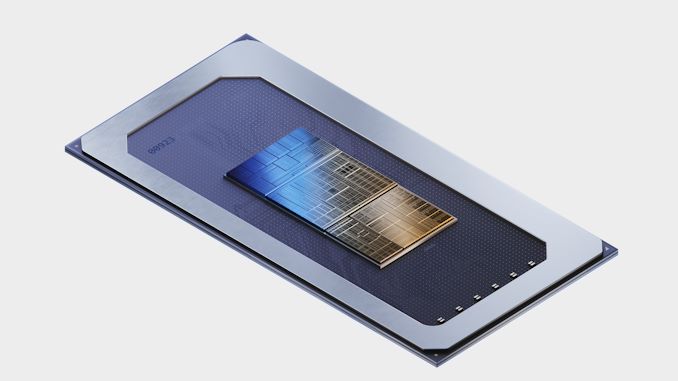
During the opening keynote at Intel's Innovation event in San Jose, Chief Executive Officer Pat Gelsinger unveiled a score of details about the upcoming Meteor Lake client platform. Intel's Meteor Lake marks the beginning of a new era for the chipmaker, as they move away from the chaotic Intel 7 node and go into a rollout of their Foveros 3D packaging with EUV lithography for their upcoming client mobile platform. Meteor Lake uses a tiled, disaggregated chiplet architecture for its client-centric processors for the first time, changing the very nature of Intel's consumer chips going forward. And, according to Intel, all of these changes have allowed them to bring some significant advancements to the mobile market.
Intel's first chiplet-based consumer CPU breaks up the common functions of a modern CPU into four individual tiles: compute, graphics, SoC, and an I/O tile. Within the makeup of the compute tile is a new pair of cores, a P-core named Redwood Cove and a new E-core called Crestmont. Both these cores promise IPC gains over their previous counterparts, but perhaps the most interesting inclusion is a new type of E-core embedded directly into the SoC tile, which Intel calls 'Low Power Island.' These new LP E-cores are designed with the idea that light workloads and processes can be taken off the more power-hungry compute tile and offloaded onto a more efficient and lower-powered tile altogether. Other major additions include a first-for-Intel Neural Processing Unit (NPU), which sits within the SoC tile and is designed to bring on-chip AI capabilities for workloads and inferencing, paving the way for the future.
With Meteor Lake, Intel is aiming to put themselves in a more competitive position within the mobile market, with notable improvements to compute core hierarchy, Intel's Xe-LPG Arc-based graphics tile looking to bolster integrated graphics capabilities, and an NPU that adds various AI advantages. Meteor Lake also sets the scene for Intel and modular disaggregation, with Foveros 3D packaging set to become a mainstay of Intel's processor roadmap for the future, with the Intel 4 process making its debut and acting as a stepping stone to what will become Intel's next mainstay node throughout its fabs, Intel 3.
Intel Meteor Lake: Intel 4 Using Foveros 3D Packaging
Intel's Meteor Lake architecture is not just another iteration in the long line of processor advancements; according to the company it's a revolutionary leap forward. Eloquently put by the executive VP and GM of Intel's Client Computing Group (CCG), Michelle Johnston Holhaus, at Intel's Tech Tour 2023 in Penang, Malaysia, she remarked that Intel had reached an inflection point in their client roadmap. Unveiling more details about Meteor Lake at the Intel Technology Tour in Malaysia, the architecture is an advancement from its current client processors regarding performance as we advance through Intel's '5 nodes in 4 years' roadmap.
Meteor Lake is built upon Intel's disaggregated architecture pushed through by Foveros packaging. This is designed to optimize both performance and energy efficiency. The architecture itself consists of four unique and distinct tiles connected via Intel's Foveros 3D packaging technology. This includes the compute tile, which is built on Intel 4, while the graphics tile is built on TSMC's N5 node. The other two tiles Intel implements within Meteor Lake are the SoC tile which acts as the central hub through the embedded NOC. This is the first time Intel has used a Network-on-Chip (NOC) on their client processors, which is a simplified approach to the NOC on their existing Agilex FPGAs. While on Agilex, the NOC is individualized into different NoC targets and switches within the substructure of the NoC, on Meteor Lake, it directly connects to the I/O fabric through the IoC, which then goes into the I/O fabric. The NOC itself is directly connected to the graphics tile, compute tile, and other components within the SoC.
This modular approach allows for a ground-up and scalable power management architecture that supports disaggregation, enabling each tile to function independently. This disaggregated design prioritizes performance by negating bandwidth bottlenecking through things like the I/O on a monolithic design and targets enhanced power efficiency. Perhaps the most notable element of disaggregation is that Intel can select specific silicon processes for each tile and isn't limited to one process node. On top of the power efficiency and package area benefits of a tiled architecture, it is cheaper for Intel to manufacture CPUs with fewer masks through EUV, but it allows Intel to scale out new IP into future products while keeping the same base, which is another cost-saving factor (for Intel).
Compared to mobile Raptor Lake, which was done using Multi-Chip Packaging (MCP), Meteor Lake uses Foveros BGA packaging and offers low-power die-to-die interconnects, which Intel confirmed has a small power penalty of between 0.15 and 0.3 picojoules (pJ) communicating from tile to tile. Some of the advantages of Foveros include better customizability through tiling, which allows Intel to manufacture chips and implement specific tiles and IP depending on the grade of the chip, etc., low power with more I/O, or high-end tiles with all the latest gadgets and gizmos. With the Intel 7 node not being as viable as they would have hoped, Intel promises higher wafer yield on Intel 4, which uses less wafer space for logic-based silicon.
Power management is done using a scalable power management system that supports the independent functioning of each tile. Coordination between multiple power management controllers (PMC) and system software is designed to be optimized for various workloads. Intel's Meteor Lake architecture also introduces a new scalable fabric to improve energy efficiency and extend bandwidth in areas that have been previously bottlenecked, such as I/O.
Touching more on the power controllers within the Meteor Lake architecture, Intel has integrated independent Power Management Controllers within each of the tiles. As part of the disaggregation of using Foveros, each tile needs to be independently power managed, and using PMCs on the NOC, the I/O fabric, as well as each tile allows power management to be agnostic depending on the number of the cores on each package.
Meteor Lake itself represents a monumental architectural shift, not just a mere incremental update, as it represents the most significant architectural transformation in client processors in four decades. This is because it's the first client processor to be made using chiplets instead of a monolithic design. The architecture is designed to be the cornerstone of Intel's strategy to push PC innovation for the next decade. Looking at some of the finer details of Intel's Meteor Lake architecture, it uses Intel's Foveros packaging technology, which uses 3D chip stacking to tackle the pitfalls of traditional 2D chip layouts.
As we can see from the above disclosure from Intel at Hot Chips 2023, the top and bottom layers have bumps for interconnecting each die together. Using the Foveros FDI packaging offers a low-voltage complementary metal oxide semiconductor (CMOS) interface, which means the power circuitry can be run with lower voltages and, thus, with a lower power envelope. Another benefit of FDI is both synchronous and asynchronous signaling, which means signal transmission can handle fully duplexed data blocks.
Constructing a Meteor Lake SoC includes a package substrate, which is the foundation for the base tile to sit onto, which uses the Foveros Die Interconnect (FDI). The base tile has a 36µm die to die pitch with metal layering and a 0.15 to 0.3 pJ operating power at 2 GHz; this may fluctuate or vary depending on voltages, amps, and frequency. As it's a base tile that isn't an active chiplet itself, its only function is to serve as a base for all of the various logic, and metal layers for the chiplets to be placed upon.
The makeup of Intel's Meteor Lake architecture uses four distinct tiles to create a Meteor Lake CPU. This includes a Compute, SoC, GPU, and an I/O tile, all with distinct uses, capabilities, and flexibility in regard to IP. Power management also gets a revamp. With disaggregation through Intel's Foveros packaging technology, each tile in Meteor Lake requires its own power management. Intel's solution is a hierarchical power management system that uses Power Management Controllers on the NoC, IO fabric, and each individual tile.
Over the next few pages, we'll give an insight into each of the four tiles, what each tile brings to the table, and more about the various technologies driving innovation through Meteor Lake.



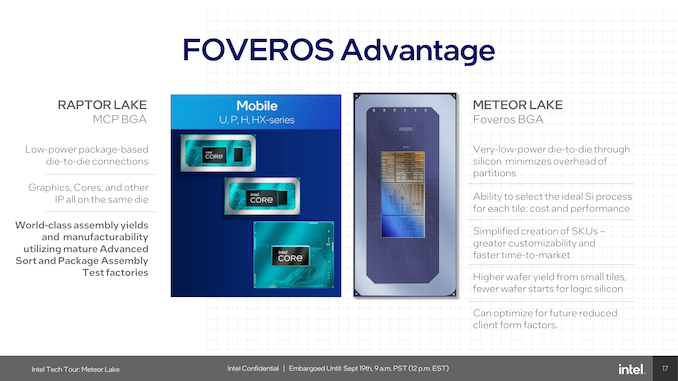

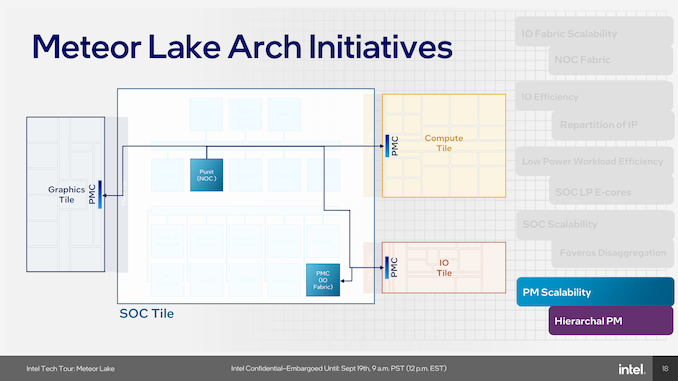
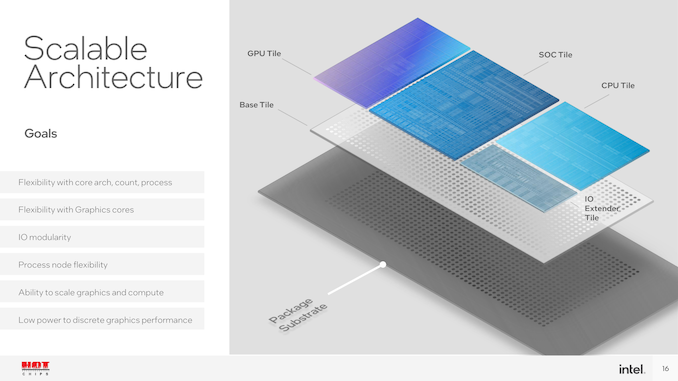
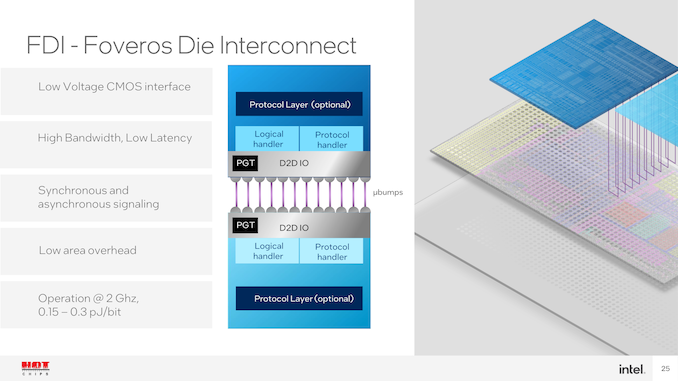
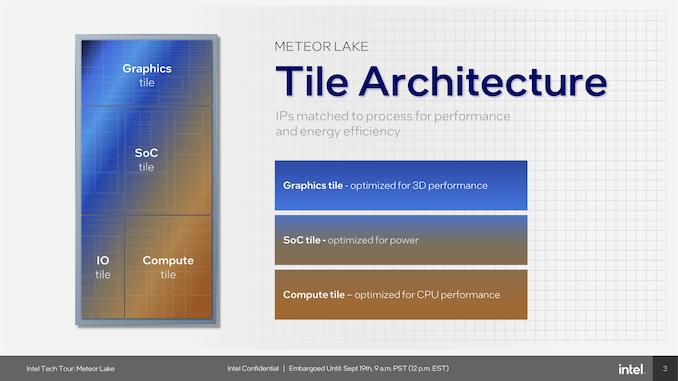








107 Comments
View All Comments
erinadreno - Tuesday, September 19, 2023 - link
Chiplets on mobile processors doesn't sound exactly enticing. Why does Intel feel the need to use 3 different types of chiplets from 2 foundries on a power-sensitive mobile chip?jazzysoggy - Tuesday, September 19, 2023 - link
It's not the same chiplet strategy as AMD is using for Zen, it's more inline with AMD's MI accelerators. Not as cheap as the Zen strategy, but much more power efficient for power sensitive mobile chips.schujj07 - Tuesday, September 19, 2023 - link
Do you have proof it is more power efficient? Intel right now is vastly less power efficient than AMD and that is regardless of chiplet or monolithic dies.Unashamed_unoriginal_username_x86 - Tuesday, September 19, 2023 - link
First page says .15-.3 pJ/bit for Foveros, AMD has previously stated infinity fabric uses "<2 pJ/bit" which presumably isn't very far under 2. this puts Intel at 5-10x the efficiency for this very specific part of data transmissionduploxxx - Wednesday, September 20, 2023 - link
first generations of infinity fabric were also less power hungry, untill they noticed what is needed to get things faster and there you go. Lots of bandwidth changes and infinity fabric changes and as well the power usage... lets see what Intel is capable of doing first, it's marketing all over the place...Samus - Tuesday, September 19, 2023 - link
Intel is behind AMD on power efficiency purely due to process node. Architecturally they are quite competitive. This is proven in how AMD performance scales when underclocked compared to Intel.Anandtech recently did an investigation into this and came to the conclusion that while the architectures are vastly different they have potentially similar performance once you determine the ideal wattage for the chip, and at the moment Intel is pushing high TDP into extremely inefficient territory to have something competitive with AMD, due to AMD being on a superior node. Basically AMD can deliver X performance at 56w while Intel can deliver X performance at 72w, but Intel can deliver Y performance at 100w while AMD delivers Y performance at 95w.
While impossible to absolutely prove, various factors can help determine this differential has more to do with manufacturing superiority than design superiority.
Intel going for tiles here is a clear attempt to close the gap on this.
PeachNCream - Thursday, September 21, 2023 - link
I think I'd second-guess anything Anandtech does these days. They had one person with an advanced degree that departed years ago after being bought out by Qualcomm when they owned Killer NICs and have since had trouble publishing articles without obvious typos and "in-a-hurry" oversights.On the other hand, if that data is supported by a more credible publisher that has decent measuring equipment and can afford to purchase its own test hardware rather than relying solely on free samples - well then we should sit up and take notice. At this point though, an Anandtech exclusive is just a reason to raise the citation needed flag and THEN further analyze the sources for their motives.
RedGreenBlue - Sunday, October 1, 2023 - link
They’ve always had typos that slip through, or grammar mistakes. All the way back to Anand’s time. I don’t like it but I know what was intended when I see one. There still isn’t another website with the same focus on the segments they focus on. I miss the deep-dives into mobile chips and phones they used to do by investigating what wasn’t publicly released about things but for most people that’s a niche purpose that other sites cover extensively with reviews and can focus on and is a bit too consumer focused and easily found elsewhere. Not really their target market.Composite - Thursday, September 28, 2023 - link
This is indeed similar to MI250 2.5D fabric. However, MI300X is full 3D fabric.elmagio - Tuesday, September 19, 2023 - link
My personal guess, from the moment this was announced, has been that they want every single cm² of silicon going through their Intel 4/EUV capacity going to the compute tile. They're lagging quite a bit behind TSMC and Samsung in terms of EUV capacity, so anything that doesn't stand to benefit much from being designed from the ground up to be made on their own nodes is worth offloading to TSMC.SoC and IO tiles are really not process-limited currently, and their Arc GPUs are in general going manufactured elsewhere anyway. But their CPU design process has always been fully in house every step of the way, and they don't want to change that (at least not yet). So everything but compute would be "wasted" Intel 4 capacity.